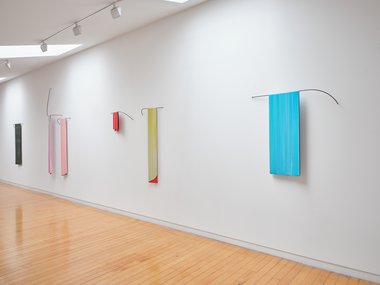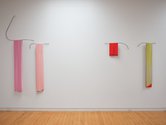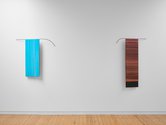John Hurrell – 21 November, 2023
In essence these are innovative and very elegant 3D abstractions celebrating line, plane and colour that scrutinise the notion of ‘support', for technically each drape of solid paint is held in place only by the long curved upper surface of the horizontally straight pewter-grey steel bar. Canvas and stretcher norms have long been abandoned in the making of these ‘paintings' that utilise plasticity to suspend folded rectangles of flexible acrylic.
Upstairs in the narrow space at Two Rooms, Christchurch artist Helen Calder presents eight two-sided works that use curved grey stainless steel rods—or rectangular racks—as devices for holding streakily-coloured draped sections of soft flexible acrylic paint; projecting out from the long white wall. Liquid paint has been left to set on Mylar, and then the skins peeled off and possibly trimmed. This method of making hangable planar sculptures from solidified paint she has been exploring since 2009, and using thin black rods for support, 2018. (The show is accompanied by a superb essay by art historian, Barbara Garrie, discussing Calder’s working processes in detail.)
The supporting thin dark horizontal metal lines are an extension of an earlier method where flexible black vertical cords were used to suspend thin flat curled acrylic skins from the ceiling. With the current firm wall supports, the bent steel often changes in elevation, rarely staying at one consistent height.
In essence these are innovative and very elegant 3D abstractions celebrating line, plane and colour that scrutinise the notion of ‘support’, for technically each drape of solid paint is held in place only by the long curved upper surface of the horizontally straight pewter-grey steel bar. Canvas and stretcher norms have long been abandoned in the making of these ‘paintings’ that utilise plasticity to suspend folded rectangles of flexible acrylic.
Each hovering oblong displays shimmering lines of long vertical or horizontal streaks, traversing bands of tiny parallel linear blurs in pale delicate hues, often with different colours on the two sides. To get these intricate markmaking effects Calder cleverly sandwiches two layers together in a transferral method expertly described by Garrie in her essay.
They look like narrow woven scarves that have an unwool-like sheen. Some are copper or brown, others pastel pink or blue, with curved bottom edges, occasionally curling. Or appear filmy. One red work has a split on its edge, like a vent in a skirt.
Amusingly, with the white walls behind them, these hangings seem to allude to bathroom towel racks, with the draped material impeccably unruckled and smoothly flat like in a five-star hotel. They also have affinities with attentive waiters with large white napkins folded over their forearms, ready for cleaning up table spills, and absorbing heat from hot crockery. Such associations tamper with the purely functional aesthetic of the exhibition-driven gallery—introducing an aristocratic political edge. For some, the elegant ambience might also be interpreted as excessively pristine, if not clinical or sterile. It all depends on how you measure the degrees of ‘tidiness’ in the title, and the types of pleasure you search for in an artwork.
From a distance, many of these unusual paintings might be mistaken for textiles, or even textured ceramics, set into smooth walls, with attendant drawn-on thick dark lines alongside. The works appear to be more architecturally motivated this way, optically (not physically) locked into the limits of the space. And while the planes float in the room, the lines, instead of anchoring, hover with them—extending slightly soft edges in the luminous air.
The whole package conveys a slightly mystical sense I think, beauty with a vaguely theosophically tinged aura tagging along. This in spite of Calder‘s project developing solely out of an exploration of the materiality of paint whilst still in the can and then poured out—thus defying conventions—and wondering if it might be brought close to supporting itself.
John Hurrell














 Advertising in this column
Advertising in this column Two Rooms presents a program of residencies and projects
Two Rooms presents a program of residencies and projects



This Discussion has 0 comments.
Comment
Participate
Register to Participate.
Sign in
Sign in to an existing account.